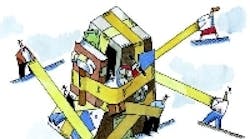When a palletload includes everything—including the kitchen sink—you have to make sure the load is wrapped right. If not, be prepared for calls from retail store locations and a lot of other unhappy people.
Few things can cause more anguish for a distribution center manager than getting the message that a pallet load of merchandise has come unwrapped in a trailer. It means a loss of time, plus extra effort for customers on the receiving end. To ship a load that consists of cartons, shovels, garbage cans and anything else found on the shelves of hardware stores takes a blend of human skills and the right machinery.
Roger Hanson, operation manager at the True Value regional distribution center in Springfield, Ore., jokingly says he sometimes wishes he were in the grocery business where cartons are of consistent sizes. "But we're not," says Hanson. "We're in the hardware business where it's all odd-ball stuff that has to move on a pallet—just right."
To solve his wrapping challenges, Hanson installed Orion Packaging Systems' (Collierville, Tenn.) gantry-style wrappers. Orion is now part of the Pro Mach consortium out of Loveland, Ohio.
The wrapping arm of these machines moves around the load rather than spinning the load on a turntable, a perfect application for loads that are irregular in shape.
"We set the machines up," says Hanson, "so the operators can place three loads at each machine, or in a 360° pattern. As one load is being wrapped, another can be moved out or in."
The pivoting mast feature of the machine adds to productivity, particularly during periods of heavy demand.
How it works
To wrap a load, the operator must first position the mast if the load has not been placed beneath it. A foot pedal releases a pin lock at the base of the mast and the operator swivels the mast, and arm carrying the film cartridge, into position.
Depressing a bar on the control panel, which, for safety purposes, faces away from the wrapping action, can then activate the wrapper. The wrapping sequence is controlled by a programmable logic controller, and uses photo sensors to adjust to wrapping loads of varying heights.
Wrapping time now is about three minutes, or half what it used to be when True Value wrapped loads by hand. The distribution center currently wraps enough pallets to fill 15 trailers per day.
Hanson says the key to proper wrapping of a mixed load begins with the operators. "It's like a puzzle game," he says. "The skill and knowledge of the operators goes beyond knowing that heavy stuff goes on the bottom and light stuff on the top."
One mixed load is positioned as another is being wrapped and a third, already finished waits to be moved to a trailer.



